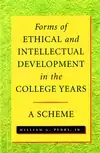Perry Theory
William Perry's Scheme of Intellectual and Ethical Development (1970) specifies a sequence of stages of development of an individual's epistemological and ethical position.[1] It is a structural theory, providing a framework into which different philosophies and sets of values can be fitted. Perry's Theoretical framework has been verified and expanded by later researchers.[2] A brief summary of Perry's original theory is as follows.[3]
| Thinking hardly or hardly thinking? Philosophy |
| Major trains of thought |
| The good, the bad and the brain fart |
| Come to think of it |
|
v - t - e |
Dualism

Simple dualism is a bifurcated structuring of the world between good and bad, right and wrong, us and them. Dualistic views are characterised by simple dichotomies, for example seeing the world as liberal vs. conservative. There is a heavy reliance on absolutes and authority[4] as the sources of truth, values and control. Knowledge is rarely justified rationally, but rather by reference to an authority. Dualism implies that actions are either right or wrong.
Multiplicity
This is a more complex structuring where there is a plurality of answers, and points of view. This is perceived as an aggregate of discretes without any internal structure or external relation. Viewpoints given are often 'Anyone has a right to his or her opinion', with the implication that no judgement can be made about the quality or validity of the opinion. An example of this is the suggestion that multiple perspectives on the origin of life should be taught in schools, on the grounds that intelligent design, young Earth creationism and evolution are all theories, and therefore equal in status.
Relativism
This is a more sophisticated and complex position, which recognizes a plurality of points of view, interpretations, frames of reference and value systems, and admits to the fact that knowledge and ethical positions are contingent on context, and judgements can be made through analysis, comparison and evaluation. Epistemologically, Relativism requires that knowledge, answers and choices are dependent upon particular features of a context, and are evaluated or justified through principled rule-based systems. A good example of relativism is in the workings of the judicial system. Although the killing of an individual is judged by society to be wrong, there are a number different ways in which that killing can be classified, and when sentencing, contextual details of the particular case are crucial in determining an appropriate custodial or other sentence.
Educators' perspectives
Perry theory is seen by many educationalists as a developmental spectrum, and that a move from simple dualism to relativism will benefit the student's intellectual growth and development; this can be done by challenging a student's dualistic or multiplistic positions.[5] A 2005 study by Steven Verhey attempted to move students from simple dualistic positions by asking them to read parts of an ID-friendly, antievolution text, as well as an online refutation of the text and parts of a book presenting evidence for evolution.[6]
See also
- Essay:The Perry Theory is a pile of bunk — one RationalWiki editor's perspective on the theory.
References
- Perry, William G., Jr. (1970), Forms of Intellectual and Ethical Development in the College Years: A Scheme (New York: Holt, Rinehart, and Winston).
- See, for example the expanded scheme developed in Belenky, Mary F.; Clinchy, Blythe M.; Goldberger, Nancy R.; & Tarule, Jill M. (1986), Women's Ways of Knowing: The Development of Self, Voice, and Mind (New York: Basic Books). A version of it can be viewed at: http://www.cse.buffalo.edu/~rapaport/perry.positions.html#perrybook
- Summary is largely taken from Ernest, P., 1991, The Philosophy of Mathematics Education, Falmer Press, pp 112-113
- http://cpcolumn.wordpress.com/2007/05/20/column-9-on-legitimate-authority-on-conservapedia/
- see, for example the suggested "challenges" to the dualistic and multiplistic positions suggested by the University of Colorado: http://www.csub.edu/TLC/options/resources/handouts/scholarship_teaching/perrystheory.html
- In fact Sixty-one percent of students in the intervention streams reported some change in their beliefs; most of these were students who had been initially sympathetic to creationist explanations and moved toward greater acceptance of evolution. For a fuller report on this see: http://www.aibs.org/bioscience-press-releases/051101_engaging_prior_learning_on_creationism_and_evolution_may_benefit_college_biology_students.html